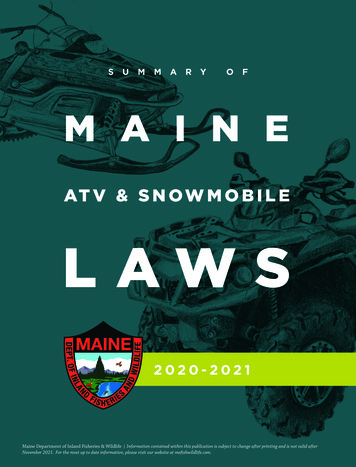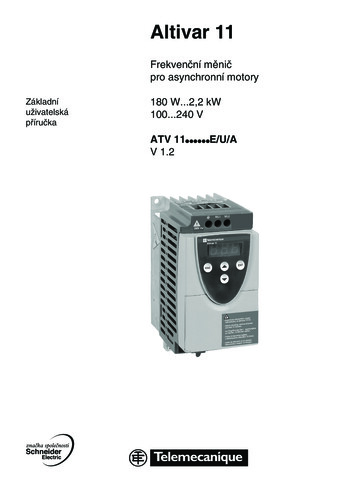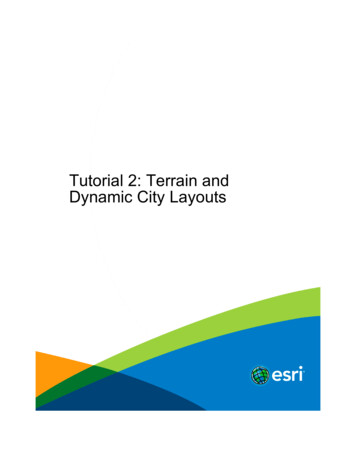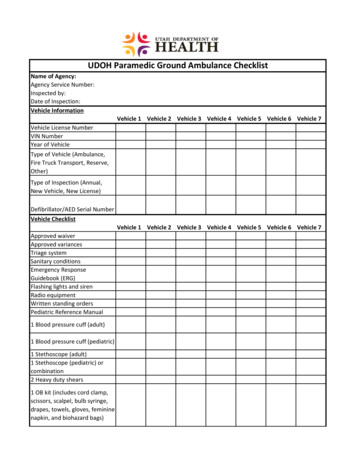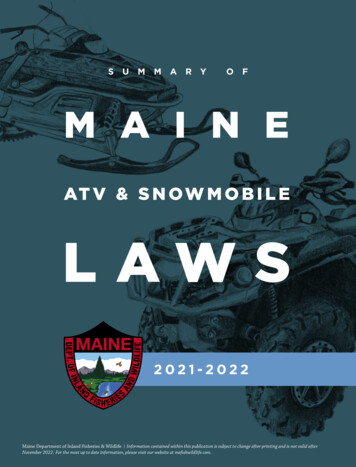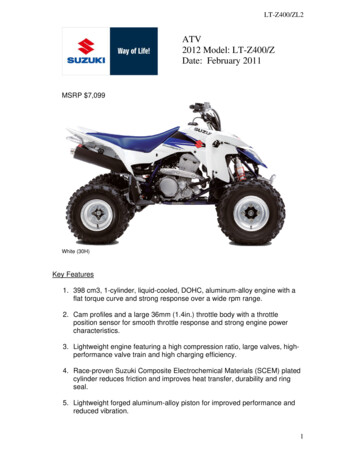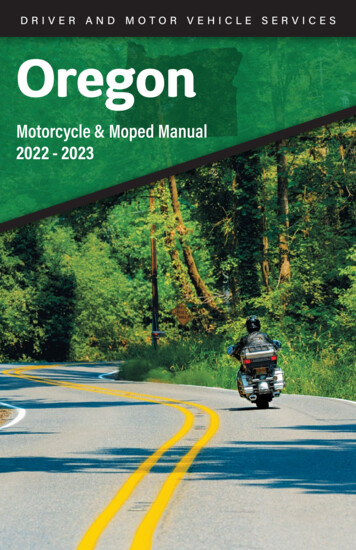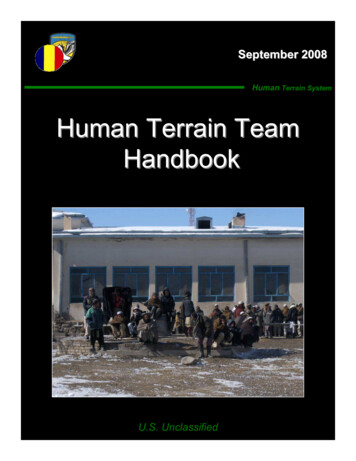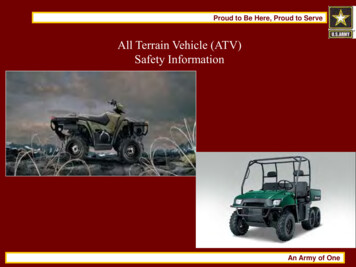
Transcription
Proud to Be Here, Proud to ServeAll Terrain Vehicle (ATV)Safety InformationAn Army of One
ATV Safety Tips Wear all recommended protective equipmentwhen riding.Know the limits of what you can and cannot do.Know the area where you will be riding.Don’t exceed experience and training limits.Before you ride, do the routine maintenance onthe vehicle (tires, brakes, lights, cables, fuellines, seat and handlebars properly adjusted).
Suggested ATV Best PracticesAn ATV is not a toy. Only children having hadspecialized training should be allowed to operatean ATV. ATVs with an engine size of 70cc to 90cc shouldbe operated by people at least 12 years of age. ATVs with an engine size greater than 90ccshould be operated only by those 16 years of age.
ATV Best Practices (continued) Read the owners manual carefully.ATVs are not made for multiple riders. Nevercarry anyone else on the ATV.Any added attachments affect the stability,operating and braking of the ATV.Just because an attachment is available doesn'tmean that it can be used without increasing yourrisk of being injured.Do not operate an ATV on streets, highways orpaved roads.
Common ATV-related injuries: Head injuries Spinal trauma Abdominal trauma Abrasions and lacerations Clavicle/extremity fractures anddislocations
ATV DeathsDeaths occur in: Collisions (56% of deaths)- more than half with fixed object Overturns (35% of deaths)- backward more common thanforward 60% occur on roadways Only 1% on ATV trails
Safety Tips WEAR SAFETY GEAR - Wear a helmet, eye protection and other protectiveclothing suitable to the environment at all times. NO ALCOHOL OR DRUGS - Operating an ATV while drinking or using drugsis not only unsafe, it is illegal. OBEY THE LAW - Learn the ATV laws in your state and those in the areas youwill be riding. OBEY THE RULES - Obey posted signs and stay on the trails. Further,Venturing from marked trails can result in a rider coming face to face withunexpected obstacles such as ditches, drop offs, cliffs, trees, etc. WATCH YOUR SPEED - Always ride at a safe and responsible speed. Knowyour abilities and don't exceed those levels. NO PASSENGERS - Do not carry passengers on your ATV. Carrying passengerson an ATV designed for a single rider can upset the balance of the machine andmakeit more likely to tip or roll over. Some of the newer ATV's are specifically designedfor two riders. The wheelbase on these machines is longer.
Safety Tips GET TRAINED - Do not let young or inexperienced riders operate ATVswithout training and supervision. Contact Resources for a safety education classnear you. http://www.atvsafety.gov/ MAINTAIN A SAFE DISTANCE - Always maintain a safe distance betweenriders. Tailgating can lead to collisions and injuries. Give the rider in front ofyou some space. You never know when they will have to stop quickly or turnsharply to avoid an obstacle. NEVER RIDE ALONE - Ride with others and let someone know where youare riding. Never ride alone. You never know when you will need help. CHECK THE WEATHER - Be informed of local weather conditions. Manyof us forget that the weather has a dramatic affect on the trails we ride. Dress andequip yourself appropriately for the weather.
Safety Tips KNOW THE AREA YOU RIDE IN - Be aware potential hazards. The betteryou know the terrain and trails in the area you will be riding the safer you willbe. If you don't know the area, find someone who does and ride with them thefirst few trips. Not only will you be safer but you will learn the trails quicker. CHECK YOUR EQUIPMENT - Make sure your equipment is in topworking order. CARRY A MAP - Carry a map of the trail or area you intend to travel. If youcan't get a map get a GPS. Most modern GPS's have a "track back" feature thatwill allow you to retrace your ride and get back to where you started. RIDE THE RIGHT ATV - Most manufacturers recommend certain sizeATV's for certain ages. Most manufacturers recommend an ATV less than 70ccfor children under 12, a 70cc to 90cc ATV for children 12 to 16 and an ATVlarger than 90cc for people over 16.
General Information Drivers must be licensed, and theirqualification to drive the GATORmust be annotated on their SF348/346. Helmet and eye protection arerequired for both driver andpassenger if driving off the ramp/offroad. The GATOR will not be driven onpublic roadways except to cross theroad at designated crossing points,or with a road guard. Passengers may not ride in the cargoarea. Cargo weighing more than 50lbs must be should in the cargo bed.
Driving Safety Climbing/Descending Hills– Always use Brakes going down hill to prevent “FreeWheeling”– Driving Across Slopes – When on Soft Terrain turn wheelsslightly uphill to keep vehicle straight– If vehicle begins to “tip over” turn front wheels Downhill toregain control– Never Cross body of water where depth unknown makingcontrol difficult to maintain.– Do NOT modify the machine– Tire Safety – Explosive separation of tire and rim parts cancause serious injury/death Correct Tire Pressure, use clip onchuck extensions and stand to one side when inflating
Licensing Drivers will complete training prior tooperating an ATV/Gator. SF346 or other driving records will beproperly annotated ATV Qualified” and/orGator Qualified by unit master driver. Training documentation will be kept by themaster driver and will include Names, Rank,SS#, Unit Assigned and dates of training.
Service Intervals DAILY–––––––––Test Safety SystemsCheck Tire PressureFuel LevelEngine Oil LevelRemove grass and debris from engine compartment,muffler area, and front grille, before and after operatingmachineClean air intakeCheck area below machine for leaksCheck drive beltCheck brakes and park brake operation
CONCLUSIONTraining Annotation on SF 348 and SF 346 for ATV/Gator Carry your license on person Wear proper PPE Leader Involvement Commander’s Guidance Driving is a privilege .easy toLOSE this privilege!!! Be the Safety Officer on-the-spot corrections Be Professionals!
Drivers will complete training prior to operating an ATV/Gator. SF346 or other driving records will be properly annotated ATV Qualified" and/or Gator Qualified by unit master driver. Training documentation will be kept by the master driver and will include Names, Rank, SS#, Unit Assigned and dates of training.
